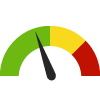Indicator Gauge Icon Legend
Legend Colors
Red is bad, green is good, blue is not statistically different/neutral.
Compared to Distribution
 the value is in the best half of communities.
the value is in the best half of communities.
 the value is in the 2nd worst quarter of communities.
the value is in the 2nd worst quarter of communities.
 the value is in the worst quarter of communities.
the value is in the worst quarter of communities.
Compared to Target
 meets target;
meets target;  does not meet target.
does not meet target.
Compared to a Single Value
 lower than the comparison value;
lower than the comparison value;
 higher than the comparison value;
higher than the comparison value;
 not statistically different from comparison value.
not statistically different from comparison value.
Trend

 non-significant change over time;
non-significant change over time; 
 significant change over time;
significant change over time;  no change over time.
no change over time.
Compared to Prior Value
 higher than the previous measurement period;
higher than the previous measurement period;
 lower than the previous measurement period;
lower than the previous measurement period;
 no statistically different change from previous measurement period.
no statistically different change from previous measurement period.
 Significantly better than the overall value
Significantly better than the overall value
 Significantly worse than the overall value
Significantly worse than the overall value
 No significant difference with the overall value
No significant difference with the overall value
 No data on significance available
No data on significance available
Children Living Below 100% Poverty Level
This indicator is archived and is no longer being updated. Click to learn more
The share of children under age 18 who live in families with incomes below the federal poverty level.
The federal poverty definition consists of a series of thresholds based on family size and composition. In calendar year 2014, a family of two adults and two children fell in the “poverty” category if their annual income fell below $24,008. Poverty status is not determined for people in military barracks, institutional quarters, or for unrelated individuals under age 15 (such as foster children). The data are based on income received in the 12 months prior to the survey.
Why is this important?
Measurement period: 2018-2022
Maintained by: Conduent Healthy Communities Institute
Last update: February 2024
Graph Selections
| Region | Source | Measurement Period | Percent | |
|---|---|---|---|---|
Data Source
- American Community Survey 5-Year
Note: This source uses Zip Code Tabulation Areas (ZCTAs) for its Zip Code data. Learn more
Maintained By: Conduent Healthy Communities Institute (Methodology)
Filed under: Economy / Poverty, Community / Social Environment, Social Determinants of Health, Children


